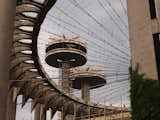Collection by Dena Al-Adeeb
Modern Architecture in Baghdad
From September 15–December 31, 2016, Chicago's Graham Foundation offers a rare look into Baghdad's post-WWII, post–1958 revolution modern building boom through the photographs and documents of Iraqi architect Rifat Chadirji, which are ordinarily held at the Arab Image Foundation in Beirut. grahamfoundation.org
Image: Rifat Chadirji, IRQ/314/153: Administration Offices, Federation of Industries, Baghdad, 1966. Photographic paste-ups, 8.27” × 11.69”. Courtesy of the Arab Image Foundation.
Detail of the mosque located within the University of Baghdad masterplan, both designed by Walter Gropius. It's presently not in use as a religious center to minimize political conflict between the Shiite and Sunni Muslim groups.
Walter Gropius, TAC (The Architects’ Collaborative) and Hisham A. Munir, University of Baghdad Campus, 1957-, Baghdad, Iraq.
Baghdad Gymnasium (Baghdad, Iraq: 1958)
History: A preservation movement has grown over this once-obscure Le Corbusier design in Iraq, a commission from King Faisal II, who wanted to rework Baghdad for an unsuccessful bid for the 1960 Summer Olympics. After Faisal was assassinated a few years later, the plans for a sports complex—which at one point included redirecting the Tigris River to feed an outdoor pool—collected dust until a Le Corbusier associate, Georges-Marc Presente, took them up in 1982 and finished the gymnasium, incorporating a curved roof and stark exterior. After Saddam Hussein was overthrown, American soldiers took up residence for a few years, exacerbating the structure’s slow deterioration.
Status: Caecilia Pieri, from the Institut Francais du Proche-Orient, rediscovered the site, which was unknown even to some members of the Le Corbusier Foundation, during a research trip in 2005 and helped focus international attention.
What You Can Do: Discussions and plans have been proposed to renovate the structure, which is still in use, but nothing concrete has materialized. Pieri has posted a great history of the project.
Image Credit: Rifat Chadirji
Mid-century greats like Le Corbusier, Wright, Sert, Gropius, Aalto and Gio Ponti were invited by King Faisal II in the 1950s to participate in the remaking of Baghdad’s modern image. Baghdad was back then a place of development, as the young King Faisal II—educated at Harrow in England and crowned in Iraq at 18—began to invest oil revenues from petroleum exports into infrastructure projects that would put the capital city back on the map. His short-lived reign as an idealistic teenage monarch may not have left much for the history books, but he did succeed in bringing in some of the world’s greatest architects to contribute to Baghdad’s urban plan.






